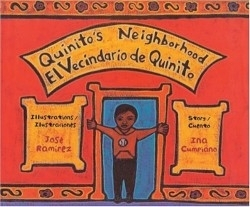Quinito's Neighborhood/El Vecindario de Quinito
“My abuela drives a big truck,” says Quinito, a small boy, as he talks about the work of his grandmother and other relatives and neighbors.
Quinito also introduces his mother, a carpenter; his uncle, a dance teacher; and a neighbor who is a baker. Quinito appears in each of the double-page paintings, either participating or watching. The Spanish and English signs in the illustrations depict a Latino neighborhood. The English text has a few embedded Spanish words, and a full Spanish version follows on each double page, with the text superimposed on the illustration.
In addition to being a poet and translator, the author has written almost twenty children’s books, including Abuela’s Big Bed: A Puerto Rican Folktale and Homes Are for Living (¿Y Tú, Dónde Vives?). With master’s degrees from the University of Northern Colorado, Johns Hopkins University, and the Iowa Writers’ Workshop, plus a PhD from the University of California, Santa Cruz, Cumpiano has won the New Millennium Writings Award and the Jaime Suárez/Editores Salvadoreños Poetry Award.
The illustrator uses sturdy attention-grabbing colors and black outlines, which are typical of his paintings. His tile murals and ceramic sculptures have appeared in museums and galleries, and he has previously illustrated children’s books, including The Frog and His Friends Save Humanity / La Rana y Sus Amigos Salvan a la Humanidad and A New Sun / Un Nuevo Sol. He teaches second grade in Los Angeles, and has presented art workshops for after-school programs, community organizations, museums, and musician’s groups.
One intriguing illustration depicts Quinito’s cousin in clown school. Her large white eyes liven up her blue face. The circles on her red pants look like fried eggs. As she juggles four balls, Quinito tosses a pink ball toward her. The phrase, “circo de la gente” (“the people’s circus),” appears in Spanish on the back wall of the stage. Quinito comments, “My grown-up cousin Tita goes to clown school.”
Quinito describes the connections among members of his neighborhood: “My neighbors, Rafi and Luis Manuel, go to work very early. Rafi bakes bread and Luis Manuel sells it.” On the next double page, Quinito says, “Mrs. Hernández sells Rafí’s bread at her bodega, too.” (Bodega means “small grocery store.”)
For children ages three to seven, this book presents a healthy view—without gender stereotypes—of a neighborhood in which the lives and work of its members are intertwined. Latino and Latina children growing up in a bilingual environment will appreciate the dual-language aspect of this book. A glossary will help English speakers learn the book’s Spanish words.
As children learn about a truck-driving grandmother and an uncle who teaches dancing, they will realize that both women and men perform diverse kinds of work, and that diverse people make a neighborhood.
Disclosure: This article is not an endorsement, but a review. The publisher of this book provided free copies of the book to have their book reviewed by a professional reviewer. No fee was paid by the publisher for this review. Foreword Reviews only recommends books that we love. Foreword Magazine, Inc. is disclosing this in accordance with the Federal Trade Commission’s 16 CFR, Part 255.

